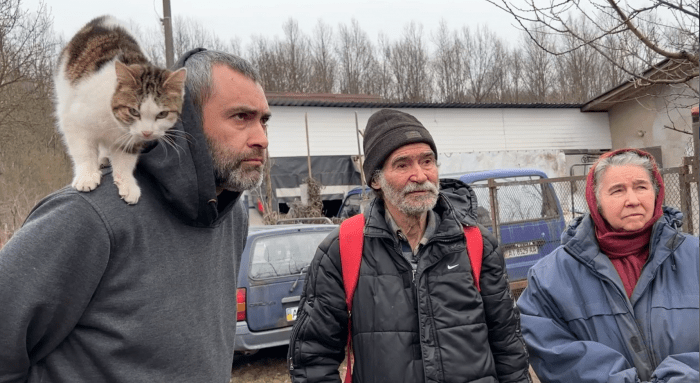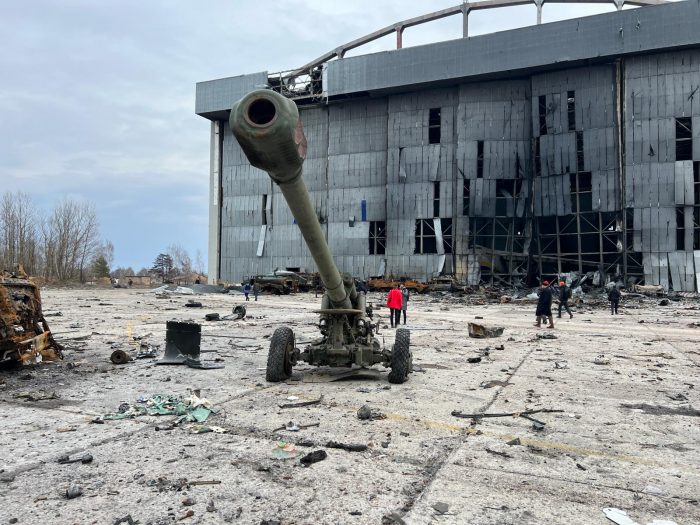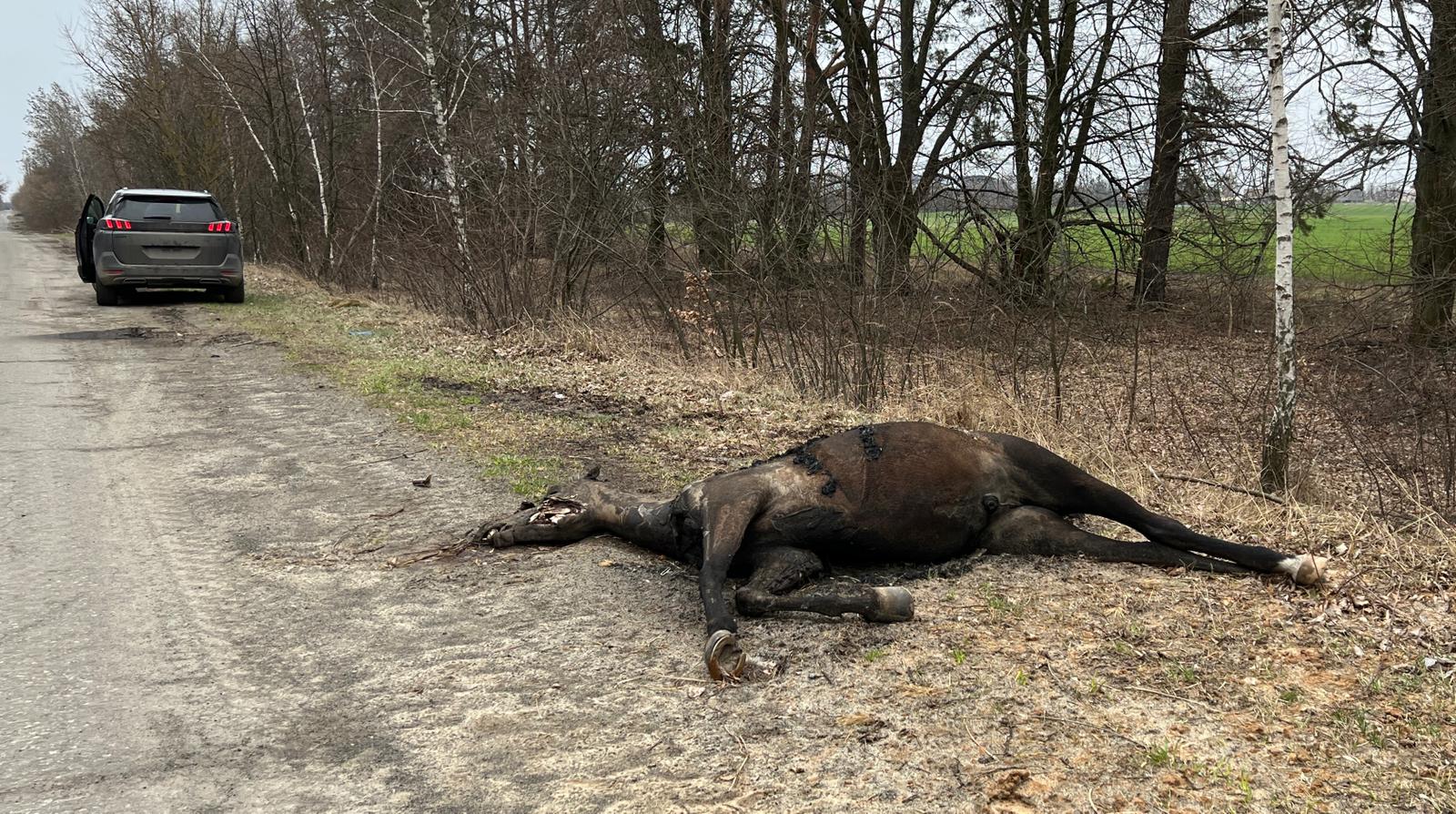As she leads us down an unpaved lane between rows of rickety village homes near Ozera village, 60-year-old grandmother Liubov describes horrific scenes that took place here only a week before. She stops in front of a home concealed by forest canopy and overgrown thickets. The only inhabitants visible around are suspicious cats. Adding to the sense of dread is the drizzle and our proximity to a ribbon of infamous Kyiv satellite towns now associated with Russian war crimes.
Irpin and Bucha are recognised worldwide, but it was the Antonov airport at the nearby town of Hostumel which brought the Russian army to the area. Ozera is next to the airport. The Russians chose the thick woodlands of Liubov’s settlement to base their attack on the airport. On March 25, they occupied a small factory, moved in artillery, Grad rocket systems and started to dig an elaborate warren of trenches. Then they called in on the neighbours.
“When they first came, they promised nothing would happen to us,” Liubov tells The Currency. “They took our phones and didn’t ask for anything else. Our neighbour, Vitya, gave them some honey.” My companion for the day, head of local emergencies services, Ivan Boiko, 37, is sceptical about Liubov’s story until she calls her neighbours out to corroborate it. We are joined by Liudmila, 65, wrapped in a man’s overcoat and scarf, her 41-year-old son, Anatoly, whose sunken eyes peers from his hoodie and another neighbour Evgeniy, 64. The scene’s gravity is undermined by a purring cat who slinks across the villagers’ shoulders as they recount their story.

A week after the first visit, different Russian soldiers came to the villagers’ homes. “They went straight to the bigger houses. One of them, which has solar panels on the roof, belonged to a builder,” said Evgeniy matter-of-factly, “They killed him in his kitchen. Then they went into a modern house next door and killed a middle-aged couple.” Evgeniy didn’t witness the killings, but Liudmila heard the gunshots. “I also heard Vitya’s voice on the lane parallel to ours. He was pleading with them not to shoot someone. But they shot that person anyway. And they shot Vitya too. After the Russians left,” Liudmila continues, “We discovered five bodies and buried them in a small clearing in the woods.” As an emergency worker, it’s not Boiko’s job to exhume or process the dead so he thanks the villagers, promises to inform the police and leaves.
Boiko’s hulking frame and foghorn voice belies an empathy which endears him to Ozera’s 500 residents. Having lived there for fifteen years, he is now the town’s fixer-in-chief. With access to emergency service vehicles and permission to drive around the area during the three-day curfew, he has taken it on himself to evacuate the sick and deliver humanitarian aid to the village. For that reason, his time is precious. “You can’t help people when they’re dead,” Boiko says as we drive off to deal with the living.
We cut through the vast expanses of untilled fields surrounding Ozera. The remains of war are visible everywhere. The ground is pockmarked with artillery craters. Roadsides are strewn with split tree trunks and punctuated by abandoned tank trenches. Beside one of them lies two dead horses. A cannon-mounted armoured vehicle hurtles wildly in front of us. The hastily painted over Russian V sign on its back hatch door indicates it’s been commandeered from Russia’s retreating forces. Two young smiling Ukrainian soldiers sit atop it triumphantly waving the Ukrainian flag.
We pass crashed and crumpled cars, riddled with bullet holes, a cruel and tragic testament to the fate visited on civilians drivers trying to flee the area. “Bastards. Animals. There are no words to describe them,” says Boiko, of the Russian troops, “All they know is kill, destroy and steal.” Boiko knows more than most about their habits because a Russian tank was stationed in an empty plot next door to his house and the tank crew stayed in his house. “I stayed in the emergency services centre while they slept in my children’s bed,” he says, “They spray-painted the V sign all over the house and on my van. And when they left they destroyed anything they couldn’t take with them. They shot holes in the wooden panelling in my kids’ room, smashed every screen in the house and destroyed my furniture.”
Working helps Boiko to block out the effects of what’s happened to him and his community, but his sadness turns to anger in a flash. “Everyone’s life here is a fucking mess right now. Normally, I do my day’s work, chill out at home with the family and go to the cinema at the weekends. Now, I’m working 20 fucking hours a day. My 10-year-old and 12-year-old kids are in the arse end of nowhere in West Ukraine without any internet. And I haven’t seen them in a month.”
Boiko’s eyes light up when we arrive at a dusty crossroads outside Ozera’s community centre where he is greeted by a dozen villagers. Many of them rely on Boiko for information as well as food and supplies so he is inundated with requests. His presence and the cigarettes he’s brought enliven the group. He jokes with them that there was a stampede for bread on the first day, and cigarettes on the second.
Ozera escaped the widescale attacks on civilians which befell Irpin and Bucha but its residents have had to live with no heat, electricity or internet access for a month. Now that food and supplies to the village are regular, morale is lifting. This is manifest in the collective will to clean up the community centre, fix its broken windows and prepare for the future. They have suffered tragedy and loss, but this is alleviated by the knowledge of Ukraine’s remarkable victory in this area against the world’s second-biggest army.

Six kilometers from Ozera, the Antonov airport at Hostumel is a theatre for Putin’s broken dreams. Centre stage is the Mriya, the heaviest, longest and widest airplane ever built. Originally developed in 1985 to piggyback the Soviet Union’s Buran space shuttle, the Mriya is now crumpled in a colossal heap, destroyed by a Russian missile. The proscenium covering it is an arched canopy, lacerated by artillery and mortar fire. Facing it is a hectare-wide graveyard of Russian armoured vehicles – a carnage of twisted metal testifying to a ferocious and unexpected victory by Ukrainian forces.
Antonov airport was prized for its runway which was long enough to land Russia’s biggest aircraft. Key to Russia’s plan for taking Kyiv was the efficient delivery of heavy equipment, supplies and troop rotations through the airport. Dozens, if not hundreds, of Russian troops perished here. Along with their vehicles. Along with any chance Putin had of taking Kyiv.


